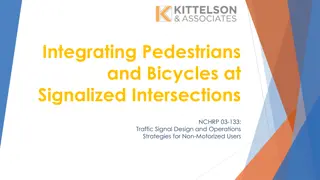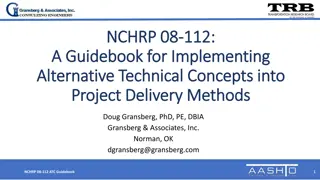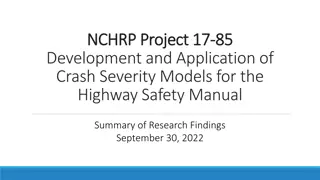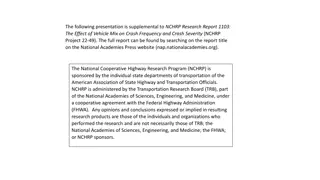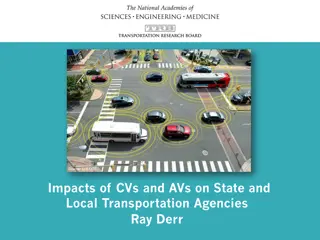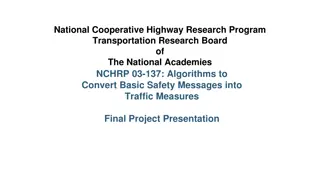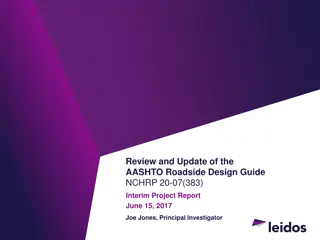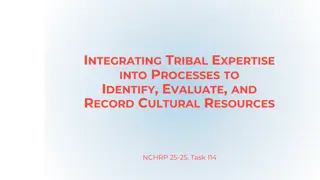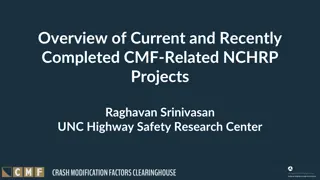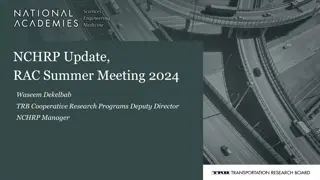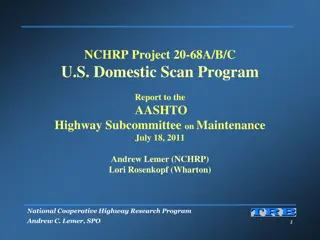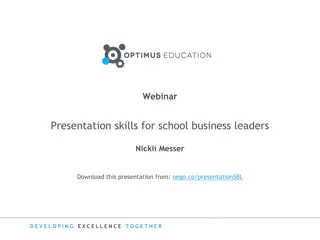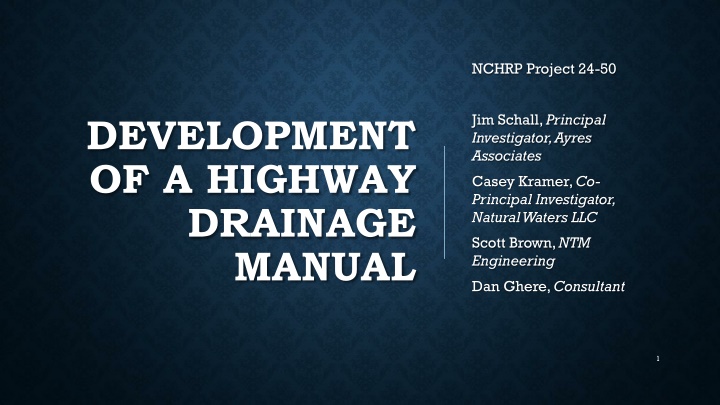
Development of Modern Highway Drainage Manual
This project aims to develop a comprehensive and updated highway drainage manual to replace the existing 2014 AASHTO Drainage Manual. The new manual will incorporate recommendations from NCHRP Project 20-07 (417) and feature three new chapters on Resilience, Aquatic Organism Passage, and Stormwater Best Management Practices. The research tasks involve literature reviews, surveys, drafting sample chapters, and producing a final report for NCHRP. The goal is to create a manual that allows for faster implementation of new technologies and research in highway drainage practices.
Download Presentation

Please find below an Image/Link to download the presentation.
The content on the website is provided AS IS for your information and personal use only. It may not be sold, licensed, or shared on other websites without obtaining consent from the author. If you encounter any issues during the download, it is possible that the publisher has removed the file from their server.
You are allowed to download the files provided on this website for personal or commercial use, subject to the condition that they are used lawfully. All files are the property of their respective owners.
The content on the website is provided AS IS for your information and personal use only. It may not be sold, licensed, or shared on other websites without obtaining consent from the author.
E N D
Presentation Transcript
NCHRP Project 24-50 Jim Schall, Principal Investigator, Ayres Associates DEVELOPMENT OF A HIGHWAY DRAINAGE MANUAL Casey Kramer, Co- Principal Investigator, Natural Waters LLC Scott Brown, NTM Engineering Dan Ghere, Consultant 1
DISCLAIMER This presentation is a deliverable of the National Cooperative Highway Research Program (NCHRP) Project 24-50. NCHRP is sponsored by the individual state departments of transportation of the American Association of State Highway and Transportation Officials. NCHRP is administered by the Transportation Research Board (TRB), part of the National Academies of Sciences, Engineering, and Medicine, under a cooperative agreement with the Federal Highway Administration (FHWA). Any opinions and conclusions expressed or implied in resulting research products are those of the individuals and organizations who performed the research and are not necessarily those of TRB; the National Academies of Sciences, Engineering, and Medicine; the FHWA; or NCHRP sponsors. 2
AASHTO TCHH recognized need to update the 2014 AASHTO Drainage Manual (ADM) Preliminary work was done under NCHRP 20-07 (417), completed in 2019 BACKGROUND Project 24-50 was awarded in August of 2021 as a 3-year project New highway drainage manual developed by NCHRP 24-50 will be provided to AASHTO for consideration as a replacement for the 2014 ADM 3
NCHRP PROJECT 20-07 (417) RECOMMENDATIONS Merge current two Volume 2014 ADM back into one volume Archive 2007 Highway Drainage Guidelines, merging relevant information into the new manual Publish as a 6-part document allowing an updates without having to republish the entire document Develop 3 new chapters: Resilience Aquatic Organism Passage (AOP) Stormwater Best Management Practices (BMP) 4
Produce a new, up-to-date highway drainage manual informed by the 2014 ADM and NCHRP 20-07 (417) NCHRP 24-50 RESEARCH OBJECTIVES Develop the new manual in a format that allows faster implementation of new technology and research Write three new chapters 5
Task 1: Literature review and conduct person-to-person survey of state transportation agencies Task 2: Develop two sample chapters, one an update from the 2014 ADM and the other on a new topic RESEARCH TASKS Tasks 3-5: Prepare the first draft, second draft and final documents, respectively Task 6: NCHRP Final Report Task 7: NHEC presentation 6
DOCUMENT ORGANIZATION Consistent format developed for each chapter: X.1 INTRODUCTION X.1.1 Overview X.1.2 Definition X.1.3 Role of the Hydraulic Engineer X.2 POLICY X.3 DESIGN CRITERIA X.4 and beyond as needed Role of the Hydraulic Engineer created given the hydraulic engineer may be a supporting team member of a larger interdisciplinary team for some transportation hydraulic design projects Policy statements rewritten in active voice Document developed in 6 technical parts, plus the glossary (7 parts total) 7
TABLE OF CONTENTS Chapter Title Part I - General Introduction Legal and Permitting Aspects Data Collection Hydraulic Studies and Documentation Software Part II Planning and Environment Planning and Location Wetlands 1 2 3 4 5 6 7 8
TABLE OF CONTENTS (CONTINUED) Part III Hydrology and River Environments Hydrology Resilience - new Channels Fluvial Geomorphology Aquatic Organism Passage -new 8 9 10 11 12 9
TABLE OF CONTENTS (CONTINUED) Part IV Highway Hydraulic Design Culverts Energy Dissipators Storm Drainage Systems Stormwater Best Management Practices (BMP)-new Storage Facilities Pump Stations 13 14 15 16 17 18 10
TABLE OF CONTENTS (CONTINUED) Part V Bridge Hydraulic Design, Scour Countermeasures and Coastal Zones Bridges Channel and Bank Protection Coastal Zone Part VI Construction and Maintenance Temporary Erosion and Sediment Control Construction Maintenance Part VII Glossary 19 20 21 22 23 24 11
MAJOR CONTENT UPDATES Current design software and application of improved numerical methods Rewritten Fluvial Geomorphology chapter Expanded information on hydroplaning, roundabout design, and curb open inlets Bridge chapter updated and organized to better align with AASHTO LRFD Bridge Design Specifications Added information on nature-based, bioengineered and biotechnical methods 12
MAJOR CONTENT UPDATES (CONTINUED) Rewritten Coastal Zone chapter Temporary Erosion Control chapter rewritten with 10 new control measures and new photos throughout New construction related information including maintaining positive drainage, temporary facilities and temporary access fills Updated glossary from HDG 13
Resilience Aquatic Organism Passage NEW CHAPTERS Stormwater Best Management Practices 14
RESILIENCE CHAPTER Many recent and ongoing projects on resilience will provide more definitive guidance in the future Content was written to summarize various studies and provide a broad overview of current state of practice A 5-step process for incorporating resilience into transportation infrastructure was included 15
AOP CHAPTER Wide range of approaches to AOP nationwide was documented by the person-to- person interviews in Task 1 Content was developed to provide an overview of common design practices in three categories: Stream simulation surrogate methods (both geomorphic and hydraulic surrogates) Geomorphic design methods Hydraulic design methods Construction of streambed habitat features included and discussion on importance of monitoring 16
STORMWATER BMP CHAPTER Similar to AOP a wide range of methods, regulatory requirements and design approaches used nationwide Design recommendations for managing stormwater runoff on project-by-project basis, Watershed approaches and regional facilities Mitigation banking Analysis approaches for runoff peak rate, volume and water quality management Discussion of pollutants of concern and treatment processes Design guidance for 13 BMP s provided 17
PROJECT COMPLICATIONS Many related reference documents in development Varying design practices throughout the country AASHTO, FHWA, NCHRP, Atlas 15 New drainage manual will need to be updated soon Modular organization should facilitate this update Document had evolved from the original MDM to the ADM ADM became more of a resource document with AASHTO recommended design practice Some chapters developed as an overview of the design methods available, without making recommendations 18
SUGGESTED RESEARCH TOPICS Updated guidance on design frequency for temporary facilities Design standards for filter diaphragms on culvert projects Rock placement design standards for culvert inlets/outlets Nationwide study on coincidental probabililty Stormwater BMP pollutant removal rates for commonly used BMP s Updated risk assessment form for encroachment design Additional research on curb open inlet and ADA grates Funding for the International BMP Database 19
CONCLUSIONS NCHRP Panel provided important information and content throughout the project Person-to-person interviews provided valuable insight NCHRP Final Report (Task 6) summarizes research approach and major results New manual developed builds on 50+ years of AASHTO contributions to highway drainage design nationwide New manual provides significantly updated content and three new chapters on critical design topics 20
DISCLAIMER This presentation is a deliverable of the National Cooperative Highway Research Program (NCHRP) Project 24-50. NCHRP is sponsored by the individual state departments of transportation of the American Association of State Highway and Transportation Officials. NCHRP is administered by the Transportation Research Board (TRB), part of the National Academies of Sciences, Engineering, and Medicine, under a cooperative agreement with the Federal Highway Administration (FHWA). Any opinions and conclusions expressed or implied in resulting research products are those of the individuals and organizations who performed the research and are not necessarily those of TRB; the National Academies of Sciences, Engineering, and Medicine; the FHWA; or NCHRP sponsors. 21
QUESTIONS 22


